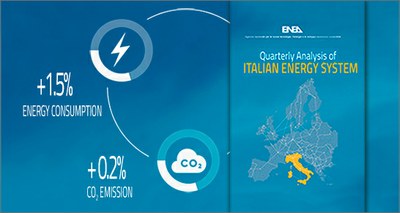Energy: ENEA Quarterly Analysis, demand recovers (+1.5%) together with CO2 emissions (+0.2%)
27/5/2021
Energy transition index worsens, Italy lags behind on low carbon technologies
 Rome - Energy consumption started recovering in 2021 after the record drop in 2020 (-10%) caused by the Covid-19 pandemic: despite decreasing in January and February (-4% each), energy demand grew by 1.5% year-over-year in Q1 2021, thanks to a strong growth in March (+15%). A double-digit growth is now expected in the second quarter and by the end of 2021 about one third of consumption lost in 2020 will likely be recovered. These are some key findings of the latest issue of ENEA Quarterly Analysis of the Italian Energy System, which also highlights a substantial worsening of the ISPRED energy transition index (-18% in Q1 2021 Quarter-over-Quarter), which monitors decarbonisation, energy security, and energy prices and affordability.
Rome - Energy consumption started recovering in 2021 after the record drop in 2020 (-10%) caused by the Covid-19 pandemic: despite decreasing in January and February (-4% each), energy demand grew by 1.5% year-over-year in Q1 2021, thanks to a strong growth in March (+15%). A double-digit growth is now expected in the second quarter and by the end of 2021 about one third of consumption lost in 2020 will likely be recovered. These are some key findings of the latest issue of ENEA Quarterly Analysis of the Italian Energy System, which also highlights a substantial worsening of the ISPRED energy transition index (-18% in Q1 2021 Quarter-over-Quarter), which monitors decarbonisation, energy security, and energy prices and affordability.
"The worsening of ISPRED results from the recovery in energy consumption, which led to CO2 emissions to grow (+0.2% in Q1) after six drops in a row. Combined with the increased EU climate targets, these data entail a substantial divergence of the Italian decarbonization pathway from the climate targets", explains Francesco Gracceva, the ENEA researcher who coordinates the analysis. “Further negative signals relate to energy security, as refinery margins were still negative and the costs of keeping the power system reliable remained very high. As regards energy prices, however, the most recent data confirm the long expected reduction of the gap between (wholesale and retail) electricity and gas prices in Italy and in the rest of Europe”, adds Gracceva.
The fall of the ISPRED index is not the only reason for concern. The most recent data about innovation on low-carbon technologies show that Italy is lagging behind large countries such as Germany, France and Spain, but also smaller ones such as Denmark, Holland, Austria, Sweden and Belgium. "For example, Germany, France, Austria and Sweden are increasingly specializing on batteries and electric mobility, a sector in which we have a specialization index of 0.6, compared to 1.4 for Germany and 1,8 for Japan and Korea. The only highly specialized sector in our country is solar thermal ", underlines Gracceva.
More specifically, the Quarterly Analysis notes that, despite the negative change in GDP in Q1 2021 (-1.4% on annual basis), energy consumption had a positive growth, due both to the strong recovery in industrial production (+8%) and, particularly for the most energy-intensive goods, and the colder climate in January and February. "For the whole of the year, it is foreseen a rebound of energy demand which should be close to the one of GDP (+4.5% according to the DEF of April 2021). But the increase could be even greater in case of a stronger recovery in mobility and, as consequence, in oil demand, towards pre-crisis values”, says Gracceva.
In terms of primary energy sources, while oil consumption decrease by 9% YOY, all others sources had a considerable growth: natural gas (+ 5%), renewables (+ 5%), net imports of electricity (+ 6%), coal (+ 17%, preliminary data; however still well below the level of Q1 2019).
As regards the demand sectors, the lower energy demand for transport (-9%), which remains much lower than before the pandemic, has been offsetted by the higher demand in industry (+7%), residential and service (+3%), non-energy uses (+ 22%).
